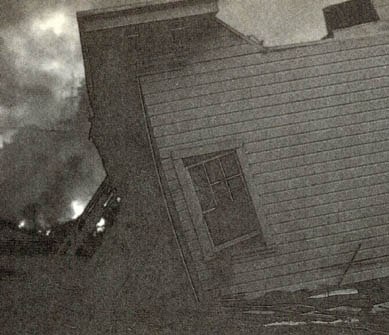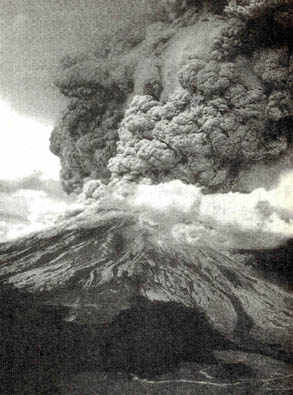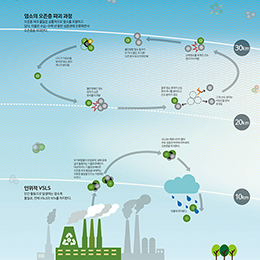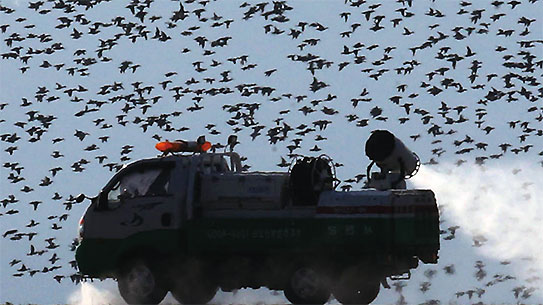
지구는 아름다운 행성이지만 안정돼 있지는 않다. 그리고 우리는 이 문제를 제어하지 못하고 있다. 과학자들은 지진을 정확히 예언할수도, 일단 지진이 시작되면 중지시킬 수도 없다. 더욱이 최근의 과학적 연구들에 따르자면 지진으로부터 안전한 지역이란 십중팔구 없다는 소식이다.
지구 표면은 육지는 물론 해저에 이르기까지 지판(tectonic plates)이라고 불리는 부분들로 갈라져 있다. 이들은 다시 맨틀 상부층과 대륙 혹은 해양의 지각으로 이루어져 있다. 이 지판들은 가소성 맨틀층 위에 위치해 있는데, 이 층을 통하여 하부 맨틀, 그리고 궁극적으로는 뜨거운 지구중심부로 부터 열이 올라온다.
바로 그 열이 대류현상을 일으켜 도처에서 지판들을 이동시키는 것이다. 또한 화산활동 과정에 지열이 분출하기도 한다. 이 두가지 현상 모두 지진, 즉 지구 내부의 충격에 의한 에너지 방출을 불러 일으킬 수 있다. 암석이 압력을 받아 부서지고 그 결과 생기는 진동이 지표에서 감지된다.
대부분 화산 분화나 지판 충돌이 지진의 원인이 되지만, 지판 경계부에서 암석 압력(rock stress)이 점증할 때에도 지진이 일어날 수 있다. 지하 대류현상이 '판 내부(intraplate)' 지진의 원인이 아닐까 추정되지만 확실치는 않다.
다음으로는 해구 바로 밑에서 일어나는 '심발(deep)' 지진이 있다. 데이비스 소재 캘리포니아 대학의 헨리 W. 그린에 따르면, 이를 '상변화(phase transformation)'로 설명해 볼 수 있다고 한다. 즉 상부 맨틀의 무기물이 '초가소성' 물질로 변하여 저항력을 상실하고, 단층대가 뻗어나갈 수 있도록 윤활제 구실을 한다는 것이다.
소규모 지진이 해마다 수천 번 발생하는데 반해, 큰 지진은 대략 2년에 한번 이상은 일어나지 않는다. 지진 에너지는 지진 활동의 리히터 규모(Richter scale)에 따라 측정한다. 진도 2 정도의 진동은 인간이 탐지해내기 어렵다. 지진의 세기는 수치가 하나씩 올라갈 때마다 약 30배씩 강해진다. 진도 6 이상의 지진은 엄청난 파괴를 불러올 수 있는데, 특히 도시 지역에서 더욱 그러하다. 지난 4천년 동안 지진으로 사망한 인구는 1천3백만명에 이르는 것으로 추산된다.
과학자들은 지진이 주기적 패턴을 띠고 발생한다는 가설에 대해서는 확신을 가지지 않는다. 또한 오랫동안 지진이 일어나지 않았을 경우 큰 지진이 발생할 가능성이 높다는 견해도 믿지 않는다. 캘리포니아 UCLA의 물리학자 데이비드 잭슨은 지진이 단층의 어느 한 부분에서 압력을 완화할 수 있다고 하더라도 그 위, 혹은 아래쪽에서는 압력을 증가시켜서 더 많은 균열을 일으킬 수 있다고 지적했다.
가장 규모가 크고 위험하다고 알려진 단층 중 일부는 종종 끔찍한 사건이 예상되는 까닭에 감시되고 있다. 그러나 지난 1월 17일, 로스앤젤레스에서 일어난 진도 6.8의 지진의 경우처럼 전에 알려지지 않았던 단층이 큰 지진을 일으키는 일이 너무나 자주 발생한다.
과학자들은 지진에 관한 연구를 계속하고 있다. 컴퓨터 시뮬레이션을 통해서 지진 물리학이 조사되고 있다. 인공위성이 지구표면을 감시하며, 실제 지진이 일어나는 동안 지면이 움직이는 모습을 보여주는 사진을 찍기까지 한다.
미국 지질국(U.S.Geological Service) 지구물리학자 윌리암 엘스워드와 스티븐 힉맨, 그리고 스탠포드 대학 출신인 마크 조백은 캘리포니아의 유명한 지진 발생지인 산안드레아스 단층에 구멍을 뚫어 감시할 것을 제안하고 있다.
미국 지질국의 미카엘 L.. 블랜피드와 스탠포드 출신인 노만 슬리프는 지진이 일어나기 전에는 지하수 압력이 커지고, 그 이후에는 물이 암석의 새로운 틈새로 흘러들어 가면서 압력이 감소한다고 생각했다. 그러나 불행하게도 일본에서 나타난 결과를 보건대, 수위를 감시하는 방법은 지진 발생을 더 정확하게 예측하는 데 별로 큰 도움을 주지 못하고 있다.
지난해 9월 인도에서 발생한 강진은 1만명을 죽음으로 몰고 갔다. 뉴욕 팰리세이드에 있는 라몬트-도허티(Lamont-Doherty) 지구 관측소의 레오나도 세버와 존 G. 암브루스터의 말에 따르자면, 이 지진은 사람들이 큰저수지에 물을 가득 채워넣었기 때문에 발생한 것인지도 모른다.
그러나 다른 과학자들은 저수지가 위험하다는 견해에 대해 동의하지 않는다. 어찌됐건 발전소, 암석 폭파 등의 여러가지 인간활동과 수많은 지진 사이에 결코 가볍게 지나칠 수 없는 우연의 일치가 존재한다는 사실에는 변함이 없다.
미국 동북부지역은 지진으로부터 안전하다고 생각하기 쉽다. 그러나 바로 그 밑 깊숙한 곳에도 오래된 단층들이 놓여 있다. 지질학자 개리 N. 노티스는 뉴욕주에서만도 약 20년 간격으로 해로운 지진이 발생한다고 말한다. 대개 피해는 가벼운 정도지만, 콜럼비아 지방에서 진행되는 프로젝트는 지진 토양 위험(earthquake soil hazards)을 컴퓨터로 처리한 지도를 만드는 것이다. 만일 깊숙한 지진 단층을 더 잘 파악할 수 있고, 건설업자들이 현명한 선택을 한다면 만일에 대비하여 더 안전한 건물을 세울 수 있을 것이다.
맨해턴 섬에는 지진 단층이 적어도 네 군데는 있다. 고층 건물들 대부분이 기반암 위에 굳게 붙박혀 있긴 하지만, 만일 맨해턴이 심하게 흔들린다면 아마 수도 본관과 하수 파이프가 부서지고 유리창들은 산산조각날 것이다.
나의 유일한 지진 경험은 캘리포니아에 체류했던 2년동안에 얻어진 것이 아니다. 맨해턴에서였다. 그때 나는 내 아파트에서 잠을 자다가, 인접한 단층들 중 하나에서 발생한 소규모 지진의 굉음을 듣고 깨어났다.
그래도 나는 여전히 그곳에서 살고 있다.

Planet Earth is beautiful but not steady, and we have no control over this problem. Scientists can't predict earthquakes accurately or stop them once they start. Furthermore, the cheery news is that if you think you live on a part of Earth that is safe from earthquakes, recent scientific studies indicate that you are probably wrong.
All the surface of Earth, ocean bottom as well as dry land, is divided up into sections called tectonic plates, made of continental or oceanic crust plus upper mantle. These plates sit on the plastic layer of the mantle, through which heat comes up from the lower mantle and, ultimately, Earth's hot core.
It is the heat that sets up currents, which move the tectonic plates around. The heat below also wells up in volcanic action. Both of these phenomena can produce earthquakes-the release of energy from a shock within the Earth. Rocks are stressed and broken, and the resulting tremors are felt on the surface.
Although most earthquakes are caused by volcanic eruptions or collisions of tectonic plates, they may occur when rock stress builds up near a plate boundary. It is suspected that currents below cause "intraplate" earthquakes-but it is not certain.
Then there are the "deep" earthquakes beneath ocean trenches. According to Henry W. Green of the University of California at Davis, a possible explanation for these is "phase transformation," in which upper mantle minerals become "superplastic," lose strength and act as a lubricant permitting the fault zone to grow.
While thousands of small and moderate earthquakes occur every year, a big one is unlikely more than once every other year or so. The energy of earthquakes is measured according to the Richter scale of seismic activity. A tremor with a magnitude of 2 is hardly detectable by a human being. With each increase in number, the strength of the earthquake goes up about 30 times, and an earthquake with a magnitude of 6 or higher can be enormously destructive, especially in urban areas. It is estimated that 13 million people have died in earthquakes over the last 4,000 years.
Scientists are not certain about the supposed cyclical pattern for quakes, or about the belief that a big quake is more likely when there has not been one for a long time. In California, UCLA physicist David Jackson has indicated that although an earthquake may relieve stress in one part of a fault, it can increase stress above and below it, causing more cracks.
Some of the biggest and riskiest known faults are monitored, often with predictions of dire events, but all too often the unexpected happens, as when a previously unknown fault caused the 6.8 magnitude earthquake in Los Angeles on Jan. 17.
Scientists keep trying to learn about earthquakes. The physics of earthquakes is being examined through computer simulations. Space satellites monitor the planet's surface, even taking pictures showing the land moving during an actual earthquake.
Geophysicists William Ellsworth and Stephen Hickman of the U.S. Geological Service, and Mark Zoback from Stanford University have proposed to monitor the San Andreas fault- California's famous earthquake producer- by drilling holes in it.
Michael L. Blanpied of the USGS and Norman Sleep from Stanford think that ground water increases in pressure before a quake and decreases afterward, when the water flows into the new rips in the rock. Unfortunately, according to results from Japan, monitoring water levels has not contributed much to improving earthquake prediction.
Last September a severe quake in India killed 10,000 people. According to Leonardo Seeber and John G. Armbruster of the Lamont-Doherty Earth Observatory in Palisades, N.Y., this earthquake may have been caused by humans filling a big reservoir.
Other scientists disagree about the danger of reservoirs, but the fact remains that there are unfunny coincidences between many earth tremors and various human activities like power stations, rock blasting, etc.
In the northeast United States we tend to feel safe from quakes, but there are old, deep faults below us. Geologist Gary N. Nottis says damaging earthquakes occur about 20 years apart in New York State alone. Usually the damage is slight, but an ongoing project in Columbia County is making a computerized map of earthquake soil hazards. If the deep earthquake faults are better understood, builders can then choose wisely and erect safer buildings-just in case.
There are at least four earthquake faults in Manhattan island. Most of the tall buildings are anchored in bedrock, but if Manhattan is shaken badly, water mains and sewer pipes will probably break and windows will shatter. My only earthquake experience did not occur during my two-year sojourn in California. I was awakened in my Manhattan apartment by a roaring sound caused by a small earthquake in one of the neighboring faults.
But I'm staying put.
(C) 1994, Los Angeles Times Syndicate

















